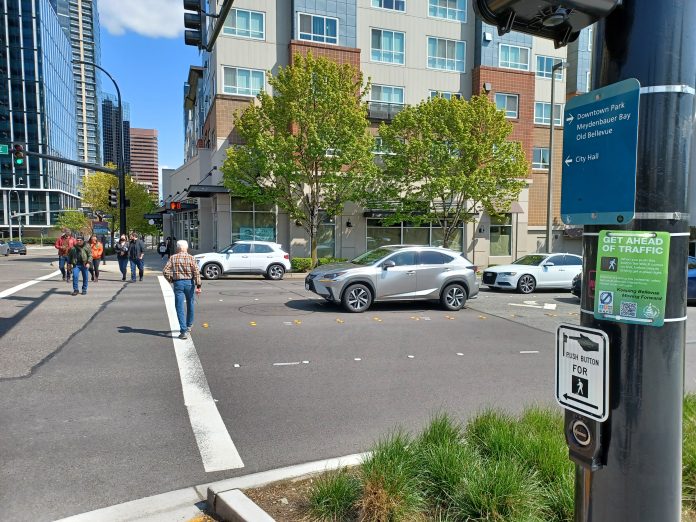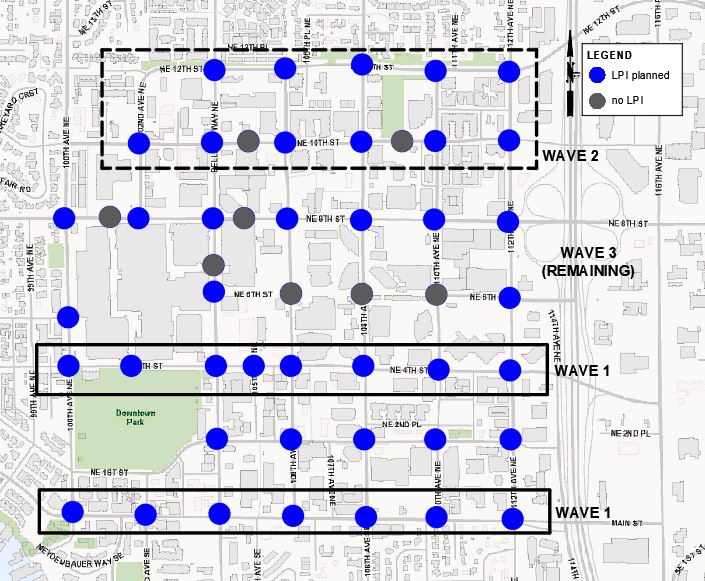
People who spend time walking or rolling around Downtown Bellevue might have noticed a slight change to their experience over the last couple of weeks. Beginning in early April, intersections along Main Street and NE 4th Street give crossing pedestrians about five seconds to enter the crosswalk before cars going in the same direction are given a green light. This change, known as Leading Pedestrian Interval (LPI), helps to reduce collisions between pedestrians and drivers by making people walking in the crosswalk more visible to drivers before they turn.
Although the change is subtle and simple — in an interview, city staff describe the implementation of LPI “like a flip of a switch” — the safety impacts for people walking and rolling are anything but. Analysis from a 2020 pilot program across 20 intersections Downtown and in Crossroads revealed that LPI helped reduce near-misses between people driving and walking by 42%.
A parallel analysis by Seattle’s Department of Transportation across 300 LPI intersections in that city showed a 48% reduction in turning collisions between drivers and pedestrians. And because implementation only requires minor edits to the city’s signal timing, LPI improvements cost significantly less than other traffic safety measures. For just the cost of staff time to code and monitor the rollout, Bellevue Transportation expect to implement the LPI program across 41 Downtown intersections by September.

At two intersections (Bellevue Way & NE 8th Street and 108th Avenue NE & NE 4th Street), Bellevue has deployed additional technology meant to increase safety. Enhanced cameras, LiDAR (Light Detection and Ranging), and artificial intelligence will identify road users by mode and interface with the city’s adaptive traffic signals to more accurately adjust timing.
Franz Loewenherz, Mobility Planning and Solutions Manager with Bellevue Transportation, explained a use case for the software for people walking at these intersections. If a person crossing the street is detected by the software to still be in the crosswalk even after the timer has expired, traffic in the cross-direction could be paused until the person has left the intersection. The program, which Loewenherz describes as “just getting going,” is using equipment loaned to the City of Bellevue by Ouster, Outsight, and Sighthound, Inc. at no cost.
Room for Further Improvement
The implementation of these low-cost programs represents a subtle shift away from Bellevue’s automobile-centric history. However, both these measures can still be seen as emblematic of Bellevue’s gradual, data-driven, and technology-focused implementation of Vision Zero. These qualities, while not inherently bad, may leave safe streets advocates wanting more improvements to be implemented more rapidly. For example, with the clear benefits of LPI — not just from data within Bellevue or Seattle, but from around the country — vulnerable road users may wonder why the program’s rollout is phased over the next five months, instead of all the changes happening at once.
David Grant, Bellevue’s Public Information Officer for Transportation, explains: “The widespread application of LPI is still pretty new for [Bellevue] so we’re rolling it out in phases to allow staff time to observe and adjust traffic signal operations, if needed. It breaks the projects into manageable numbers of intersections and also allows staff to apply any lessons learned to the next phase of implementation.”
This approach would be more understandable if signal phasing order had been changed dramatically (e.g. if an intersection’s traffic cycle had been changed to allow pedestrians to cross before left-turning vehicles), but this does not appear to be the case at intersections where LPI has thus far been implemented.
As seen in the video below, left-turning vehicles at many intersections are still allowed to proceed before people walking in the corresponding crosswalk. The Urbanist’s Anton Babadjanov has observed how intersections along NE 4th Street have historically given priority to drivers turning left before pedestrians, and it does not appear that LPI implementation has changed this paradigm.
Additionally, since right turns on red are still allowed at LPI intersections, speedy drivers turning right can still enter crosswalks while pedestrians have a walk signal. True pedestrian priority would require a wider revision of the city’s signal phasing to allow people walking and rolling to cross first, combined with a citywide no-right-turn-on-red policy.
Although these changes would likely require policies and expenses that are beyond the scope of this low-cost program, staff can cite statistics that illustrate how right-on-red policies increase collisions with pedestrians as justification for the change. In other words, there’s no need to reinvent the wheel.
Finally, the use of technology to detect pedestrians and cyclists and adjust signal timings accordingly has promise, but there’s also room for caution. The AI and camera systems used at the two Downtown intersections are similar to technology used by autonomous vehicles to detect people walking and rolling, and those systems haven’t always had the best track record.
Responding to concerns that such technology might have issues detecting people with darker skin tones, Loewenherz observed that, although transportation staff are not experts on machine learning, they remain “cognizant of broader themes [in the literature] and are monitoring that and asking similar questions… At the end of the day, we want to make sure everyone gets home safe.”
And to Bellevue’s credit, the above projects are only two examples of how the city plans to realize that vision. From foundational work beginning in the next month on possible speed limit reductions, to soon-to-come bicycle network buildouts in the city’s growth areas, to the potential for increased Vision Zero funding in the upcoming budget cycle, there’s certainly a lot of improvements to look forward to.
Update: The article was updated at 2:05pm to list additional partners involved in the city’s deployment of AI and LiDAR technology.
Chris Randels is the founder and director of Complete Streets Bellevue, an advocacy organization looking to make it easier for people to get around Bellevue without a car. Chris lived in the Lake Hills neighborhood for nearly a decade and cares about reducing emissions and improving safety in the Eastside's largest city.


